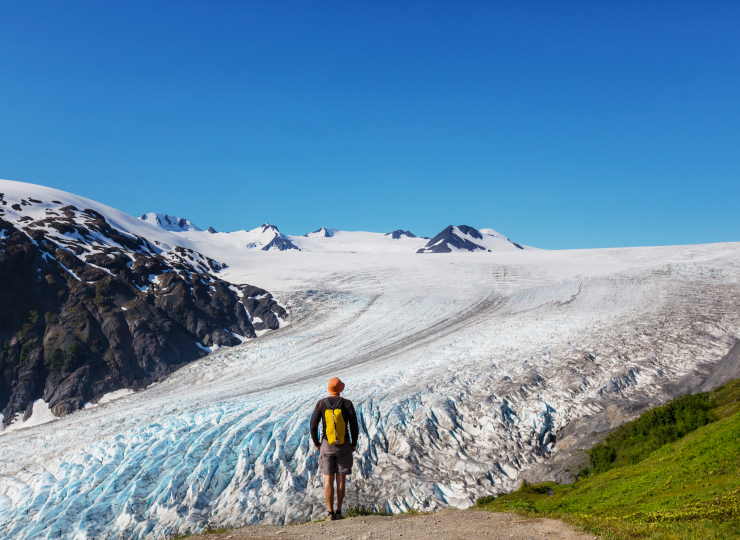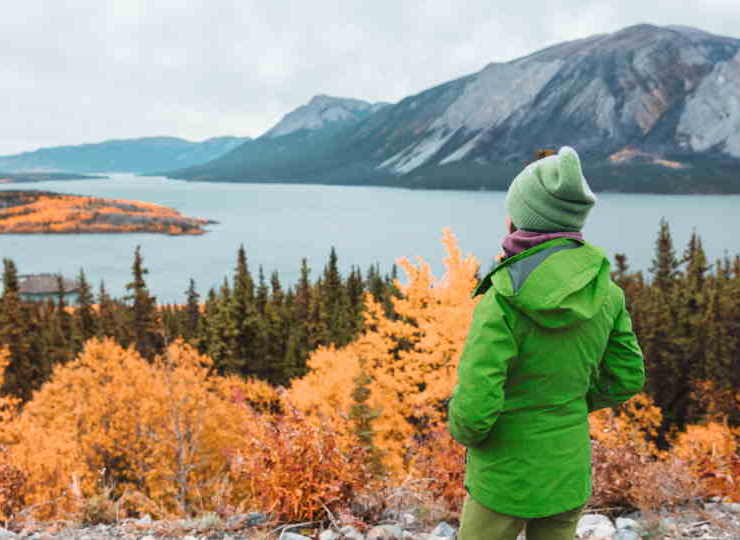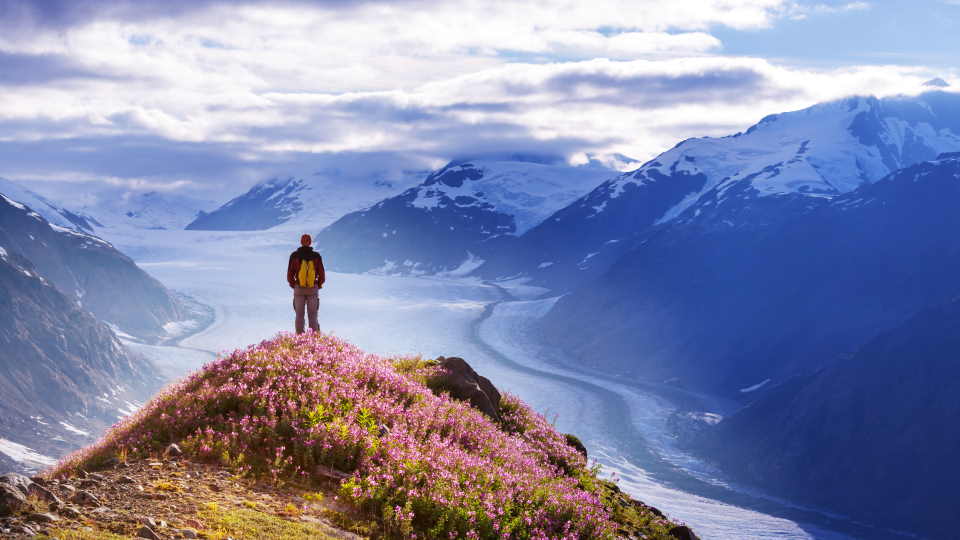Introduction
Alaska is a region that can have the most beautiful views of the south with its natural beauties and the most magnificent wildlife images, but it is a great hiking spot for those looking for adventure and unusualness.
So, is it safe to hike in Alaska?
To answer this question, the sources of danger and the measures that can be taken to prevent these sources of danger are emphasized by detailing certain issues.
Is It Safe to Hike in Alaska With Bears?
Alaska is one of the areas most worth hiking, but what about the bears? Is it safe to hike there?
Well, it is important to take certain precautions for hiking in Alaska, which is the area where 3 North American bear species live and is very popular in this sense. In this respect, it is debatable how safe Alaska is for hiking as a bear region.
Although Alaska is a region where bears are popular, a bear may come your way, or perhaps you get attacked while hiking unexpectedly. In this context, do not forget that if your hiking route is in Alaska, you might experience a much more adrenaline-filled experience. Of course, in this case, seasonal variables should also be taken into account. For example, summer can be an ideal season for bears that are asleep in winter.
Nevertheless, Alaska has taken precautions such as warnings and signs over time, which has developed in this situation, and is on the way to doing what is necessary. Although bear cases are less frequent than in the past, most of the victims who encounter bears or are attacked are the people who ignore these precautions and warnings.
Apart from what has been said, humans’ abuse of environmental factors should also be considered. The violation of their natural life and the deterioration of their resources, such as food, by human factors, cause the deterioration of the order and adaptations of bears and many other wildlife animals, and in this context, they attack areas such as cities or towns during the period when they should hibernate.
Apart from Alaska, this event is happening everywhere.
For this reason, people should not violate all kinds of environmental conditions, and the vital adaptations of living things should not be disturbed, regardless of whether it is hiking. Otherwise, not only do bear attacks may increase in Alaska, but deer attacks also come into play, which are as popular as bears.
Do You Need Bear Spray to Hike Alaska?
While the bear spray is not a completely necessary tool for hiking in Alaska, it is recommended to carry it. In other words, it is optional, depending on the hiker’s choice.
So what is this bear spray, and what does it do?
Although technically bears are not aggressive animals, they are unpredictable when they feel threatened or within different variables. Accordingly, if you encounter a mother bear with cubs looking for food, the bear spray will protect you and your belongings effectively. Accordingly, bear spray is a kind of pepper spray used against bears and their attacks.
So how to use it?
First, the canister of the bear spray is pulled out, and the seat clip is removed. At this stage, you need to place your fingers on the ring and your thumb on the trigger attached to the top. Most bear spray cans have a safety strip, so you won’t encounter unwanted accidents while hiking.
In the next stage, you should aim slightly downwards between yourself and the path where the bear is. At this stage, you should hold the spray bottle firmly with both hands and aim directly at the road in between for a healthier result. At a 30-degree angle, you should make sure that the bear is moving to reach you at your target point and take the wind into account.
Finally, you should spray the bear spray at the designated target at intervals of 1 to 2 seconds. While spraying in this manner until the bear changes direction, slowly step back and try to get away.
Considering what has been said, bear spray is recommended in areas where bears are the majority, in this case, Alaska.
How Do You Stay Safe Hiking in Alaska?

Alaska, where its nature stands out with its national parks and woodlands, is the ideal route for those who want to spend an extraordinary holiday, plus, it is one of the perfect spots worth hiking. In line with the importance that the public attaches to natural life, precautions have been taken inside the area, and it amazes itself completely in terms of culture.
In connection with the points mentioned and explained above, what precautions should be taken for hiking in Alaska and what should be considered?
First of all, you have to consider the weather factor. You should be aware that Alaska’s temperature drops to -45 degrees in winter and is around 34 degrees in summer. You should keep the necessary equipment with you by paying attention to the seasonal variables of the time you will go. Supportively, it will be vital to have suitable winter or snow shoes, coats, and tools for hiking in winter.
On the other hand, you should determine a good route for yourself and examine the conditions of these routes beforehand. Accordingly, Anchorage-Flattop, Exit Glacier Trail, Horseshoe Lake Trail, Tony Knowles Coastal Trail, Eagle River Nature Center, Talkeetna Lakes Park, Creamer’s Field, Ward Lake Trail, Wynn Nature Center, and Trail of Time at the Mendenhall located in Alaska Glacier Visitor’s Center 10 has been identified as the best, safe and easy hiking areas. Hiking, preferably in groups, at such points will be very safe.
On the other hand, it would be best to take certain precautions for adrenaline lovers who want to walk alone and want to cross the borders.
For example, the seasonal factor just mentioned above should never be ignored. Remember that even at 34 degrees in summer, the weather can be savage. You should take into account the possibility of thick and long-lasting fogs and proceed.
Besides, it should be emphasized that the signal rate of connected mobile phones will decrease. Do not be surprised if your mobile phone has no signal, especially during the hiking experience at high levels.
Is It Safe for a Woman to Travel to Alaska Alone?
Traveling as a solo woman in Alaska is safe, but it is necessary to be careful and take precautions in all kinds of situations. For example, your tour or trip should be well-planned, and you should have a good wilderness guide.
So much so that Alaska is a region where nature and wildlife come to the fore, much more than traveling to a tropical island.
As a solo female hiker, traveling to Alaska will be perfectly safe within the above-mentioned safe zones. On the other hand, remember that when going outside the borders, it is much safer to be in a group!
On the other hand, Alaska’s people should also be mentioned. Knowing that many are sensitive to nature and still have a protective attitude toward cultures is necessary. Accordingly, although they may seem cold or scary at first glance, they are extremely warm-blooded and friendly people.
As a female hiker traveling alone, knowing the people of the region in advance and being able to store the necessary information related to it, in this case, this can be their culture, food habits, and traditions.
As another issue, if you feel insecure or afraid about solo hiking, it is recommended to go on a group and guided trips, so you can have more practice and experience.
If all these are to be recovered, as stated at the beginning, yes, it is safe to hike as a solo female in Alaska.
How Do You Avoid Bears When Hiking?

So what should be done to avoid encountering bears or to avoid problems when we encounter them?
Before answering this question, it is necessary to emphasize again that Alaskans are extremely fond of nature, and they have taken many precautions not to spoil the natural life, and they expect sensitivity from people in line with these measures.
On the other hand, you, as a hiker, can take some precautionary behaviors as follows;
- If you encounter a bear, do not approach it, and do not violate its natural habitat. Like all other animals, bears have personal space, and if this area is violated, they feel that they or their cubs are under threat. This results in the bear becoming aggressive, causing it to switch from the state it was in a while observing to the aggressive mode. So, in short, give them space!
- Do not engage in loud actions during hiking; this could be singing, talking loudly, or making noise in some way. In case you have unintentionally violated the bear’s personal space, always try to take quiet and calm steps so that you do not attract the bear’s attention and cause it to attack you, feeling threatened.
- On the other hand, you should be careful not to scare the bears. In this case, you can continue walking in the presence of certain noises and sounds that may occur in nature, accompanied by a quickie, so that the surprised animal does not attack you by being startled.
- NEVER feed bears. Remember that as every animal has its adaptation, they have a diet within this adaptation. Keep in mind that bears can become aggressive in case of deficiency or excess of the diet, which is disrupted by a factor such as humans. On the other hand, avoid throwing waste and dirty garbage into the environment during hiking so that problems do not arise if bears eat such substances.
- In addition, never run, scream, or make sudden movements that will frighten the bear and trigger it to become aggressive when you encounter a bear. Remember that bears can run much faster than you. Therefore, do not try to run away from them.
- Finally, as a precaution, you can carry the bear spray mentioned above with you.
Are There Grizzlies in Alaska?
Alaska is home to 3 types of bears: Black Bears, Brown (Grizzly) Bears, and Polar Bears.
Black bears are one of the smallest bears, and they have black fur, as their name suggests. Depending on the variables, their fur colors can be brownish or cinnamon-like, but they may vary.
On the other hand, brown bears, also called grizzly bears, which are detailed below, can be described as general bears. Having more growth traits than black bears, grizzly bears are good fishermen.
On the other hand, polar bears are quite different from the other two because their fur is completely white. They are excellent swimmers, though they spend most of their lives on the edge of the sea and ice.
Speaking specifically for Alaskan grizzly bears, also known as Kodiak bears, they mostly live on the island of Kodiak. The colors of Alaskan grizzly bears can be brown or varied. For example, brown bear species have been encountered in many colors, from yellow to chestnut. While they are generally known as good fishermen, they like to feed on salmon and many other fish species.
While the average weight of males can vary between 390 and 650 kg, this figure is 20% less in females. As they prepare for hibernation towards the end of summer, they consume large amounts of salmon and venison to store fat during this period. On the other hand, they have diets that can be enriched with plants.
Conclusion
Ultimately, although the population of the Alaskan bear is higher than in other regions, it will be extremely invaluable to be seen and hiking under certain precautions, and it is a very safe region.
Accordingly, considering the question of “Is it safe to hike in Alaska?” and the points mentioned above, whether it is a matter of a solo female hiker or a group of hikers, bears, deer, or cold weather conditions, Alaska will be a unique and safe region for hiking.





Also I believe that mesothelioma cancer is a unusual form of cancers that is commonly found in all those previously subjected to asbestos. Cancerous tissue form inside mesothelium, which is a protective lining which covers the vast majority of body’s bodily organs. These cells typically form inside lining from the lungs, abdominal area, or the sac that encircles the heart. Thanks for expressing your ideas.
Hi, I enjoy your blog and I resonated with this entry the most. . Where might I learn more?
That’s pretty compelling. Can I counter with a few questions?